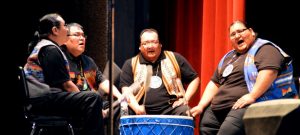The Creekside Singers hold nothing back. Four to six big men sit around a big drum beating in unison. They uncork big, raw voices higher than you ever thought chest voice could go. Phrases begin with gutsy swoops, notes waver with exertion, lines weave downward and end in expressive drop-offs. This is Northern Plains singing – fierce, dauntless, proud.
Almost everything about traditional Sioux music is wildly different from European classical music. (Out of habit, we tend to say Western music to differentiate classical concert music from other traditions – whereas of course Native American music originates far to the west of any European music. I’ll use the word classical here, recognizing its own limitations.) But one thing is the same: a given Lakota song, as much as a Beethoven symphony, is always performed exactly the same way, with all due respect to individual expression. Lakota songs are an oral tradition, meticulously memorized.
This one characteristic in common makes it possible to attempt a fusion of these vastly different-sounding musics. My task sounded simple enough: create an arrangement of “Amazing Grace” for the Creekside Singers to perform with the South Dakota Symphony. I am not the first to attempt such a fusion, but I certainly learned a lot in trying, and felt both humbled and exhilarated by the outcome.
Why “Amazing Grace”? Because it has become traditional Lakota repertory, in a very Sioux version: upbeat, irregular in meter, and with transformed melodic contours. It was the choice of the tribal musicians and elders who, one day in February, were talking with South Dakota Symphony Music Director Delta David Gier, planning an upcoming program in the long-running Lakota Music Project. I was sitting in as Music Alive Composer-in-Residence with the SDSO. To cap an evening of traditional Lakota songs interspersed with thematically chosen orchestral selections, what would Creekside like to sing with the orchestra?
“Amazing Grace.” I volunteered to do the arrangement: what could be easier to write out? Little did I know.
Although they don’t use notation or refer to fixed pitches, I found that Emanuel Black Bear – Keeper of the Drum – always begins Amazing Grace on an A-flat, in the key of D-flat. He advised that if they do several verses (we wanted three) they would probably go up in pitch and get a little faster. I needed to know, of course, exactly how much higher: a classical orchestra can hardly adjust its pitch along the way. So he made a cell-phone recording of the Creekside Singers, in rehearsal, doing three verses, or “push-ups” as they call them. Miracle of miracles, the verses were pretty precisely in D-flat, then D, then E. I dissected exactly how the lead singer on each verse comes in a little more than a measure before he’s echoed by the rest of the group. And it was a good thing I discovered the 4/4 bars sprinkled among the 3/4.
I made an arrangement with simple intro’s and outro’s to each “push-up,” featuring solo violin at the outset, then a solo French horn for the second verse, and a ringing trumpet call for the third. I knew it could be disastrous to double the melody itself, as Native singers have not only a different sense of being “in tune,” but also differently tempered intervals in their ears. So I kept it simple. I tried to be a little imaginative with textures, with maybe some countermelodies.
The rehearsal was my first experience of singers drowning out the orchestra. When have you had to ask brass to play louder to balance unamplified voices? I implored the basses to dig in harder – the bass line being the most crucial aspect of “Western” music, the basis of harmony! And why oh why had I written mezzo-pianos in the first verse? That was my classical thinking. Everyone just needs to play really loud!
From where I sat at the performance, it was a glorious riot of sound from two worlds at once, meshing more or less. Frankly, I could hear only snatches of the orchestra. Somehow, the keys lined up. The lead-ins worked, the 4/4 bars worked. And on top of it all, a 10-year-old Lakota girl did a charming Shawl Dance throughout. Although only an arranger, I was so proud of us all – if not a papa, a godfather perhaps.
It was another arrangement on the program that revealed a pitfall and an essential question about bridging cultures musically. Singing along with the orchestra, a traditional singer consistently came in too high, even though the arrangement was made to match the pitch of a recording he made singing solo. When he started on the note that felt right to him, it was a third higher than the orchestra, and that created a polytonality that was actually quite beautiful. By degrees, he settled down into the key of the arrangement – a very satisfying melding. Unintentionally, but very naturally, a process of meeting on common ground was acted out before our ears.
Perhaps that polytonality captured what we’re doing here – finding common ground as equals between two long musical traditions – better than the glorious noise of my “Amazing Grace.” Or maybe these were two different angles and outcomes of a noble effort. I have composed a number of pieces incorporating ideas and instruments from traditional Korean music (gugak). I have taken a different approach to each, to dramatically different effects, and I expect to discover more.
Can we really expect – do we really need – indigenous musicians to adopt the conventions of classical music, in order to collaborate? Indeed, are there aspects of classical identity and convention we might suspend to help a collaboration? I’ll be listening for answers to these questions and more, as I continue the adventure of learning from Native American music and musicians.






